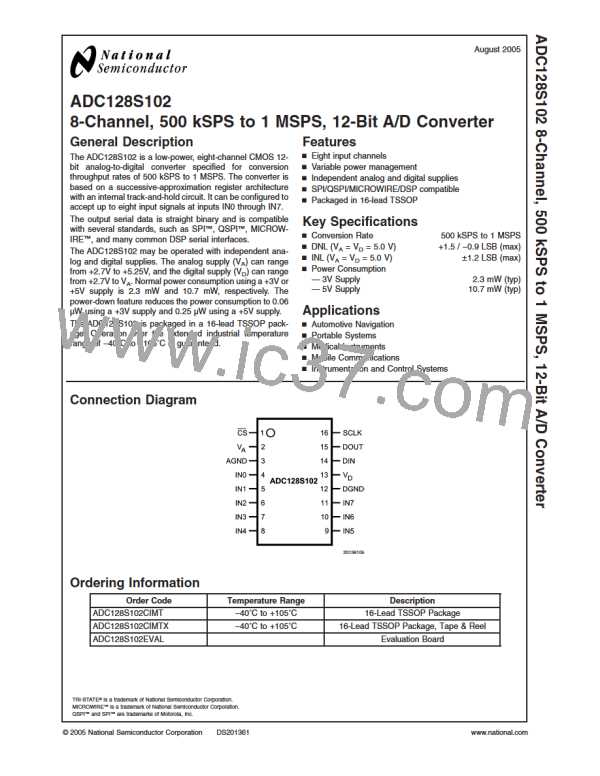second or the third order intermodulation products to the
sum of the power in both of the original frequencies. Second
order products are fa fb, where fa and fb are the two sine
Specification Definitions
ACQUISITION TIME is the time required for the ADC to
acquire the input voltage. During this time, the hold capacitor
is charged by the input voltage.
wave input frequencies. Third order products are (2fa fb
and (fa 2fb). IMD is usually expressed in dB.
)
APERTURE DELAY is the time between the fourth falling
edge of SCLK and the time when the input signal is internally
acquired or held for conversion.
MISSING CODES are those output codes that will never
appear at the ADC outputs. The ADC128S102 is guaranteed
not to have any missing codes.
CONVERSION TIME is the time required, after the input
voltage is acquired, for the ADC to convert the input voltage
to a digital word.
OFFSET ERROR is the deviation of the first code transition
(000...000) to (000...001) from the ideal (i.e. GND + 0.5
LSB).
CHANNEL-TO-CHANNEL ISOLATION is resistance to cou-
pling of energy from one channel into another channel.
SIGNAL TO NOISE RATIO (SNR) is the ratio, expressed in
dB, of the rms value of the input signal to the rms value of the
sum of all other spectral components below one-half the
sampling frequency, not including harmonics or d.c.
CROSSTALK is the coupling of energy from one channel
into another channel. This is similar to Channel-to-Channel
Isolation, except for the sign of the data.
SIGNAL TO NOISE PLUS DISTORTION (S/N+D or SINAD)
Is the ratio, expressed in dB, of the rms value of the input
signal to the rms value of all of the other spectral compo-
nents below half the clock frequency, including harmonics
but excluding d.c.
DIFFERENTIAL NON-LINEARITY (DNL) is the measure of
the maximum deviation from the ideal step size of 1 LSB.
DUTY CYCLE is the ratio of the time that a repetitive digital
waveform is high to the total time of one period. The speci-
fication here refers to the SCLK.
SPURIOUS FREE DYNAMIC RANGE (SFDR) is the differ-
ence, expressed in dB, between the rms values of the input
signal and the peak spurious signal where a spurious signal
is any signal present in the output spectrum that is not
present at the input, including harmonics but excluding d.c.
EFFECTIVE NUMBER OF BITS (ENOB, or EFFECTIVE
BITS) is another method of specifying Signal-to-Noise and
Distortion or SINAD. ENOB is defined as (SINAD - 1.76) /
6.02 and says that the converter is equivalent to a perfect
ADC of this (ENOB) number of bits.
TOTAL HARMONIC DISTORTION (THD) is the ratio, ex-
pressed in dBc, of the rms total of the first five harmonic
components at the output to the rms level of the input signal
frequency as seen at the output. THD is calculated as
FULL POWER BANDWIDTH is a measure of the frequency
at which the reconstructed output fundamental drops 3 dB
below its low frequency value for a full scale input.
GAIN ERROR is the deviation of the last code transition
(111...110) to (111...111) from the ideal (VREF - 1.5 LSB),
after adjusting for offset error.
INTEGRAL NON-LINEARITY (INL) is a measure of the
deviation of each individual code from a line drawn from
negative full scale (1⁄
2
LSB below the first code transition)
where Af1 is the RMS power of the input frequency at the
output and Af2 through Af10 are the RMS power in the first 9
harmonic frequencies.
through positive full scale (1⁄
2
LSB above the last code
transition). The deviation of any given code from this straight
line is measured from the center of that code value.
THROUGHPUT TIME is the minimum time required between
the start of two successive conversions. It is the acquisition
time plus the conversion time.
INTERMODULATION DISTORTION (IMD) is the creation of
additional spectral components as a result of two sinusoidal
frequencies being applied to an individual ADC input at the
same time. It is defined as the ratio of the power in either the
www.national.com
8

 NSC [ National Semiconductor ]
NSC [ National Semiconductor ]